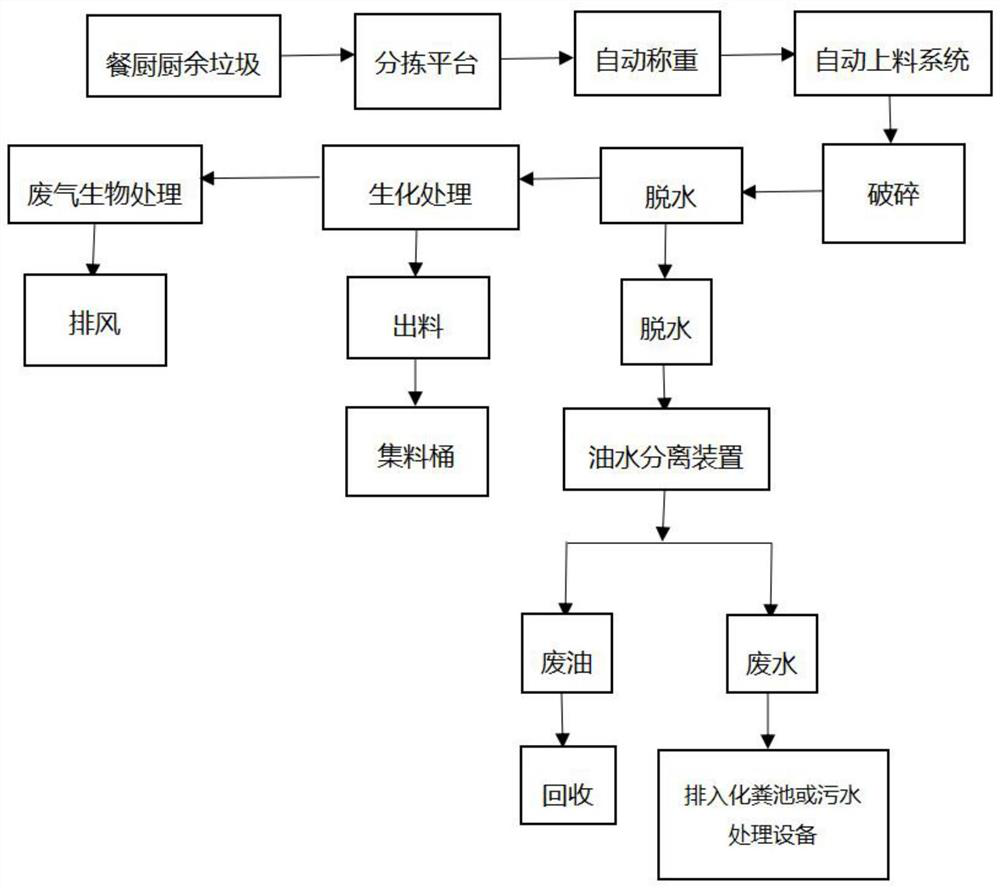Kitchen garbage treatment method with biological deodorization function
A technology for kitchen waste and biological deodorization, which is applied in the treatment of biological organic parts, separation methods, chemical instruments and methods, etc. The effect of microbial growth
- Summary
- Abstract
- Description
- Claims
- Application Information
AI Technical Summary
Problems solved by technology
Method used
Image
Examples
Embodiment 1
[0029] A method for treating kitchen waste with biological deodorization function, comprising the following steps:
[0030] S1: Crushing and dehydration, the food waste is poured into the crushing equipment through the automatic feeding system for crushing, and then sent to the dehydration equipment for dehydration, and the initial reduction is carried out through crushing and dehydration to obtain oily wastewater and solid phase kitchen waste; among them , the automatic feeding system is an automatic hydraulic lifting device
[0031] S2: Wastewater treatment, step S1 is crushed and dehydrated to obtain oily wastewater and input into oil-water separation equipment for oil-water separation, waste oil is recycled and then treated again, and the wastewater is directly discharged into septic tanks or sewage treatment equipment;
[0032] S3: Biochemical treatment, the solid-phase kitchen waste obtained in step S1 is added to the composite microbial flora and additives, heated and s...
Embodiment 2
[0048] A method for treating kitchen waste with biological deodorization function, comprising the following steps:
[0049] S1: Crushing and dehydration, the food waste is poured into the crushing equipment through the automatic feeding system for crushing, and then sent to the dehydration equipment for dehydration, and the initial reduction is carried out through crushing and dehydration to obtain oily wastewater and solid phase kitchen waste; among them , the automatic feeding system is an automatic hydraulic lifting device
[0050] S2: Wastewater treatment, step S1 is crushed and dehydrated to obtain oily wastewater and input into oil-water separation equipment for oil-water separation, waste oil is recycled and then treated again, and the wastewater is directly discharged into septic tanks or sewage treatment equipment;
[0051] S3: Biochemical treatment, the solid-phase kitchen waste obtained in step S1 is added to the composite microbial flora and additives, heated and s...
Embodiment 3
[0067] A method for treating kitchen waste with biological deodorization function, comprising the following steps:
[0068] S1: Crushing and dehydration, the food waste is poured into the crushing equipment through the automatic feeding system for crushing, and then sent to the dehydration equipment for dehydration, and the initial reduction is carried out through crushing and dehydration to obtain oily wastewater and solid phase kitchen waste; among them , the automatic feeding system is an automatic hydraulic lifting device
[0069] S2: Wastewater treatment, step S1 is crushed and dehydrated to obtain oily wastewater and input into oil-water separation equipment for oil-water separation, waste oil is recycled and then treated again, and the wastewater is directly discharged into septic tanks or sewage treatment equipment;
[0070] S3: Biochemical treatment, the solid-phase kitchen waste obtained in step S1 is added to the composite microbial flora and additives, heated and s...
PUM
 Login to View More
Login to View More Abstract
Description
Claims
Application Information
 Login to View More
Login to View More - R&D
- Intellectual Property
- Life Sciences
- Materials
- Tech Scout
- Unparalleled Data Quality
- Higher Quality Content
- 60% Fewer Hallucinations
Browse by: Latest US Patents, China's latest patents, Technical Efficacy Thesaurus, Application Domain, Technology Topic, Popular Technical Reports.
© 2025 PatSnap. All rights reserved.Legal|Privacy policy|Modern Slavery Act Transparency Statement|Sitemap|About US| Contact US: help@patsnap.com

